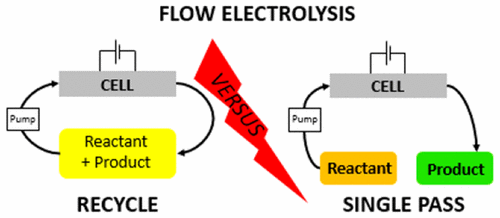当前位置:
X-MOL 学术
›
Chem. Rev.
›
论文详情
Our official English website, www.x-mol.net, welcomes your feedback! (Note: you will need to create a separate account there.)
Flow Electrolysis Cells for the Synthetic Organic Chemistry Laboratory
Chemical Reviews ( IF 62.1 ) Pub Date : 2017-09-18 00:00:00 , DOI: 10.1021/acs.chemrev.7b00360 Derek Pletcher 1 , Robert A. Green 1 , Richard C. D. Brown 1
Chemical Reviews ( IF 62.1 ) Pub Date : 2017-09-18 00:00:00 , DOI: 10.1021/acs.chemrev.7b00360 Derek Pletcher 1 , Robert A. Green 1 , Richard C. D. Brown 1
Affiliation

|
Electrosynthesis has much to offer to the synthetic organic chemist. But in order to be widely accepted as a routine procedure in an organic synthesis laboratory, electrosynthesis needs to be presented in a much more user-friendly way. The literature is largely based on electrolysis in a glass beaker or H-cells that often give poor performance for synthesis with a very slow rate of conversion and, often, low selectivity and reproducibility. Flow cells can lead to much improved performance. Electrolysis is participating in the trend toward continuous flow synthesis, and this has led to a number of innovations in flow cell design that make possible selective syntheses with high conversion of reactant to product with a single passage of the reactant solution through the cell. In addition, the needs of the synthetic organic chemist can often be met by flow cells operating with recycle of the reactant solution. These cells give a high rate of product formation while the reactant concentration is high, but they perform best at low conversion. Both approaches are considered in this review and the important features of each cell design are discussed. Throughout, the application of the cell designs is illustrated with syntheses that have been reported.
中文翻译:

合成有机化学实验室的流通池
电合成可以为合成有机化学家提供很多帮助。但是,为了在有机合成实验室中被广泛接受为常规程序,必须以一种更加用户友好的方式来呈现电子合成。文献主要基于玻璃烧杯或H槽中的电解,这些电解槽的合成性能通常很差,转化率非常低,而且选择性和重现性通常很低。流通池可以大大提高性能。电解参与了连续流动合成的趋势,这导致了流通池设计方面的许多创新,使得通过反应物溶液单次通过反应池就可以将反应物高度转化为产物的选择性合成成为可能。此外,合成有机化学家的需求通常可以通过循环使用反应液的流通池来满足。当反应物浓度高时,这些电池可提供较高的产物形成速率,但它们在低转化率下表现最佳。本文中考虑了两种方法,并讨论了每种电池设计的重要特征。贯穿整个过程,利用已报道的合成说明了细胞设计的应用。
更新日期:2017-09-18
中文翻译:

合成有机化学实验室的流通池
电合成可以为合成有机化学家提供很多帮助。但是,为了在有机合成实验室中被广泛接受为常规程序,必须以一种更加用户友好的方式来呈现电子合成。文献主要基于玻璃烧杯或H槽中的电解,这些电解槽的合成性能通常很差,转化率非常低,而且选择性和重现性通常很低。流通池可以大大提高性能。电解参与了连续流动合成的趋势,这导致了流通池设计方面的许多创新,使得通过反应物溶液单次通过反应池就可以将反应物高度转化为产物的选择性合成成为可能。此外,合成有机化学家的需求通常可以通过循环使用反应液的流通池来满足。当反应物浓度高时,这些电池可提供较高的产物形成速率,但它们在低转化率下表现最佳。本文中考虑了两种方法,并讨论了每种电池设计的重要特征。贯穿整个过程,利用已报道的合成说明了细胞设计的应用。



























 京公网安备 11010802027423号
京公网安备 11010802027423号